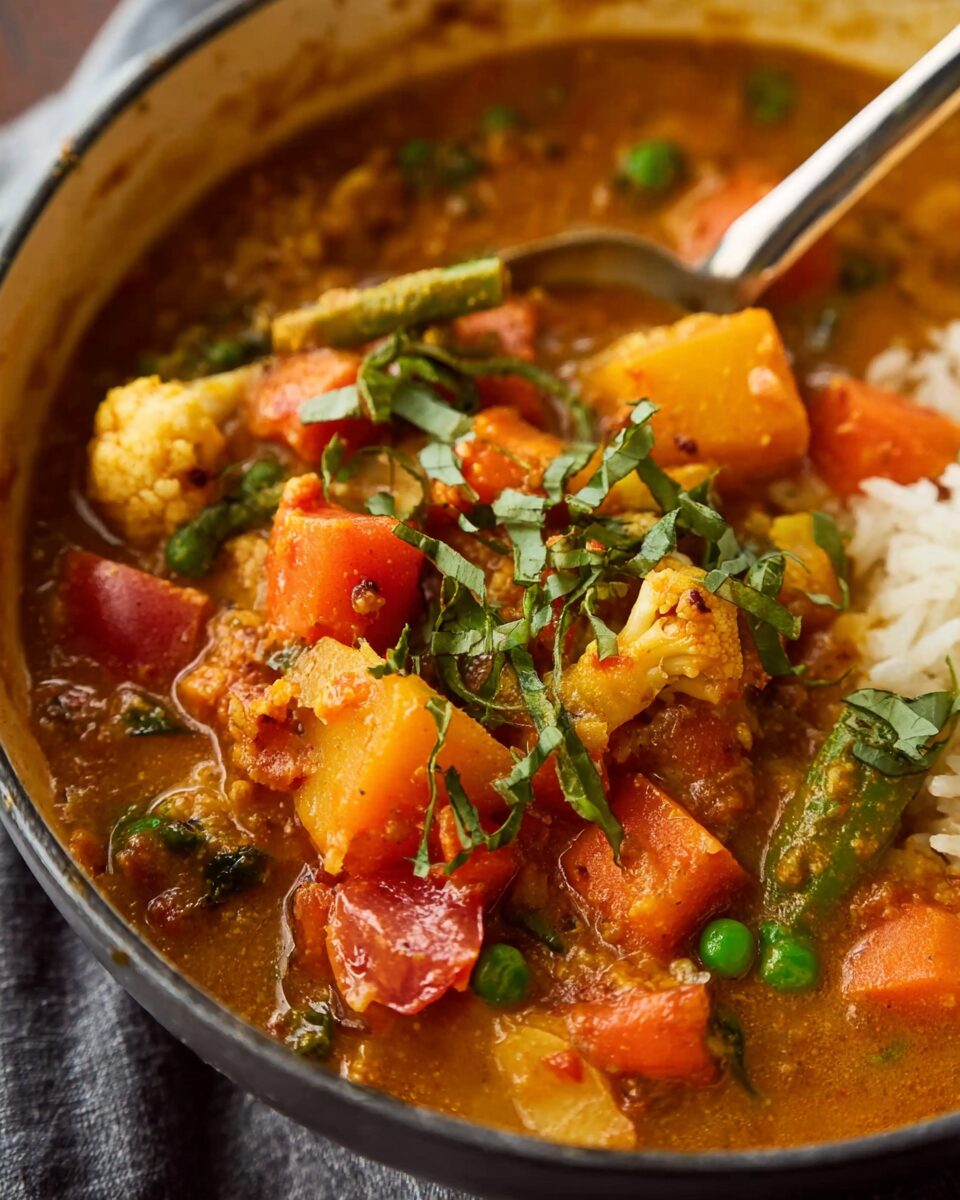This vegetable curry is a vibrant and aromatic dish that combines a blend of warming spices with tender vegetables. The creamy coconut milk creates a luscious texture that balances the heat from the spices and gives each bite a comforting richness.
Perfect for a weeknight dinner or a cozy weekend meal, this curry is versatile and easy to make. You can add any vegetables you like, and it pairs wonderfully with rice or naan bread. Whether you’re a fan of bold flavors or simply looking for a healthy, plant-based meal, this vegetable curry is sure to become a go-to dish in your recipe collection.
Full Recipe:
-
1 tablespoon olive oil
-
1 onion, finely chopped
-
2 cloves garlic, minced
-
1 tablespoon grated ginger
-
1 tablespoon curry powder
-
1 teaspoon turmeric
-
1 teaspoon cumin
-
1/2 teaspoon chili powder (optional for heat)
-
2 medium carrots, peeled and diced
-
1 zucchini, diced
-
1 bell pepper, chopped
-
1 potato, peeled and diced
-
1 can (14 oz) diced tomatoes
-
1 can (14 oz) coconut milk
-
1 cup vegetable broth
-
2 cups spinach, chopped
-
Salt and pepper to taste
-
Fresh cilantro for garnish (optional)
Directions:
-
Heat olive oil in a large pot over medium heat. Add chopped onion, garlic, and grated ginger, and sauté until fragrant, about 3-4 minutes.
-
Stir in curry powder, turmeric, cumin, and chili powder. Cook for another 1-2 minutes to release the spices’ flavors.
-
Add carrots, zucchini, bell pepper, and potato to the pot, stirring to coat the vegetables with the spices.
-
Pour in the diced tomatoes, coconut milk, and vegetable broth. Bring to a simmer and let cook for 20-25 minutes, or until the vegetables are tender.
-
Season with salt and pepper to taste. Stir in the chopped spinach and let it wilt for 2-3 minutes.
-
Serve hot, garnished with fresh cilantro if desired.
Prep Time: 10 minutes | Cooking Time: 30 minutes | Total Time: 40 minutes
Kcal: 250 kcal | Servings: 4 servings
Introduction to Vegetable Curry
Vegetable curry is a beloved dish around the world that blends the richness of aromatic spices with a variety of fresh vegetables. This dish is comforting, flavorful, and incredibly versatile, making it a favorite for both vegans and non-vegans alike. The fusion of spices and textures creates a mouthwatering meal that satisfies both the body and the soul.
Vegetable curry has roots in Indian cuisine, where curry spices have been used for centuries. Over time, this dish has been adapted by different cultures, each putting its own spin on the recipe. From the rich, creamy curries of the Indian subcontinent to the milder, coconut-based curries in Southeast Asia, vegetable curry offers endless possibilities for customization and creativity.
The History and Origins of Vegetable Curry
The origins of vegetable curry can be traced back to ancient India, where the word “curry” itself comes from the Tamil word “kari,” which means sauce or gravy. Traditional Indian curry was made by combining a blend of spices with vegetables or meats, cooked together to create a flavorful dish.
As the British Empire expanded, curry spread to other parts of the world, including Europe and Southeast Asia. The British colonization of India played a significant role in the popularization of curry outside of its native region. Over time, vegetable curry became an accessible and loved dish worldwide, with variations that suit local tastes and available ingredients.
Health Benefits of Vegetable Curry
Vegetable curry is not only delicious but also packed with nutrients. The dish typically includes a variety of vegetables, such as carrots, zucchini, potatoes, and spinach, providing a wealth of vitamins and minerals. These vegetables are rich in antioxidants, fiber, and essential nutrients that support overall health.
One of the standout health benefits of vegetable curry is its high content of vitamins A, C, and K, all of which contribute to immune function, skin health, and bone health. Additionally, the use of spices like turmeric, cumin, and ginger adds anti-inflammatory properties to the dish, which can help reduce the risk of chronic diseases and improve digestion.
The addition of coconut milk in many vegetable curry recipes provides a creamy texture while also offering healthy fats, which can help keep you feeling full and satisfied. These fats are particularly beneficial for those following a plant-based diet, as they provide a source of energy and support brain function.
How to Make Vegetable Curry Suitable for Different Dietary Needs
One of the many reasons vegetable curry is so popular is its adaptability. Whether you follow a vegan, gluten-free, or low-carb diet, there are simple modifications you can make to ensure the dish meets your specific dietary requirements.
Vegan Options: Vegetable curry is naturally vegan, as it’s typically made with plant-based ingredients such as vegetables, legumes, and coconut milk. However, if you’re looking for added protein, you can incorporate tofu, tempeh, or chickpeas into the dish for a satisfying, protein-packed meal.
Gluten-Free Options: Most vegetable curry recipes are inherently gluten-free, as they do not contain wheat or gluten-based ingredients. However, it’s essential to double-check any pre-made curry pastes or spice mixes, as some may contain gluten. Always opt for fresh, whole ingredients or check labels for gluten-free certification.
Low-Carb and Keto Options: If you’re following a low-carb or keto diet, you can make simple swaps to reduce the carb content of vegetable curry. For example, you can replace potatoes with cauliflower or another low-carb vegetable. You can also reduce the amount of coconut milk or use unsweetened almond milk for a lighter version.
Nut-Free Options: Some vegetable curry recipes may include nuts, such as cashews or almonds, to add creaminess and texture. If you have a nut allergy, simply omit these ingredients and use extra coconut milk or a dairy-free cream alternative to maintain the creamy consistency.
Common Variations of Vegetable Curry
Vegetable curry is incredibly versatile, and it can be modified in many ways to suit different tastes. Here are some popular variations:
Thai Green Curry: This variation of vegetable curry uses a green curry paste made with ingredients like green chilies, garlic, lemongrass, and kaffir lime leaves. The result is a spicier, more fragrant curry with a hint of citrus.
Mango or Sweet Potato Curry: For a sweeter version of vegetable curry, you can add ingredients like mango or sweet potatoes. These provide a natural sweetness that balances out the spices and adds an extra layer of flavor.
Lentil and Chickpea Curry: For a heartier and more protein-packed version, lentils and chickpeas can be added to vegetable curry. These legumes absorb the flavors of the curry and create a filling, satisfying meal.
Coconut Curry: Coconut milk is a key ingredient in many vegetable curry recipes, and it adds a creamy, tropical flavor. If you prefer a lighter coconut curry, you can adjust the amount of coconut milk or use a combination of coconut milk and vegetable broth.
Indian vs. Thai Curry: The primary difference between Indian and Thai curries is the type of spices used. Indian curries often feature cumin, coriander, turmeric, and garam masala, while Thai curries are more likely to include lemongrass, lime leaves, and kaffir lime. Both offer unique and delicious flavor profiles, and you can experiment with both to find your preferred taste.
How to Serve and Pair Vegetable Curry
Vegetable curry is incredibly versatile when it comes to pairing it with other dishes. The most common way to serve vegetable curry is with rice, such as basmati rice, jasmine rice, or even cauliflower rice for a low-carb option. The rice helps absorb the curry sauce and balances out the richness of the dish.
For a more traditional experience, serve your curry with warm naan bread, which is perfect for scooping up the curry and soaking up all the delicious flavors. If you’re following a gluten-free diet, you can opt for gluten-free naan or serve the curry with a side of quinoa, which is a great gluten-free alternative.
To complete the meal, consider adding a side of raita (a yogurt-based sauce) or a fresh cucumber salad to provide a cooling contrast to the spices. You can also top the curry with fresh cilantro and a squeeze of lime for added freshness and brightness.
Conclusion
In conclusion, vegetable curry is a flavorful, nutritious, and highly adaptable dish that can be enjoyed by people of all dietary needs. Its rich history, health benefits, and versatility make it an excellent choice for anyone looking to enjoy a plant-based meal that is both satisfying and delicious. Whether you’re new to curry or a seasoned pro, experimenting with different vegetables, spices, and variations allows you to create a dish that suits your tastes and dietary preferences. So, why not bring the warmth and comfort of vegetable curry into your kitchen and enjoy a vibrant meal with family and friends?





